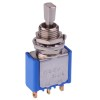Introduction
Toggle switches are a fundamental type of electrical switch that has been widely used across various industries for decades. Known for their robustness, reliability, and ease of operation, toggle switches provide a simple yet effective means of controlling the flow of electricity. This blog post delves into the world of toggle switches, exploring their types, applications, and why they remain an indispensable component in modern electrical systems.
What is a Toggle Switch?
A toggle switch is a mechanical device designed to open or close an electrical circuit by moving a lever or handle from one position to another. The term “toggle” refers to the mechanism inside the switch that provides a snap action when the lever is moved, ensuring a positive connection or disconnection of the circuit. Toggle switches come in a variety of configurations and sizes, each tailored for specific applications.
Key Features of Toggle Switches
- Durability: Built to withstand frequent use and harsh environments.
- Reliability: Offers consistent performance over long periods.
- Versatility: Suitable for a wide range of voltages and currents.
- Ease of Use: Simple and intuitive design for easy operation.
Types of Toggle Switches
Toggle switches can be categorized based on several factors, including actuator style, contact configuration, and mounting method. Below are some common types:
1. Single Pole Single Throw (SPST)
The simplest form of toggle switch, where one terminal connects to another. It functions as an ON/OFF switch.
2. Single Pole Double Throw (SPDT)
This type has three terminals: one common terminal and two others that can be connected alternatively. Useful for switching between two different circuits.
3. Double Pole Single Throw (DPST)
Comprises two separate SPST switches operated by a single lever. Ideal for simultaneously opening or closing two circuits.
4. Double Pole Double Throw (DPDT)
Combines two SPDT switches controlled by a single actuator. Provides more complex switching capabilities.
Additional Variations
- Illuminated Toggle Switches: Incorporate built-in LEDs for visual indication.
- Momentary Toggle Switches: Return to their original position after being pressed.
- Key Lock Toggle Switches: Require a key to operate, adding security features.
Applications of Toggle Switches
Due to their versatility and reliability, toggle switches find extensive use in numerous fields:
- Consumer Electronics: Remote controls, power tools, audio equipment.
- Automotive Industry: Interior lighting, hazard lights, accessory control.
- Industrial Controls: Machinery, robotics, automation systems.
- Aviation and Marine: Cockpit instrumentation, navigation aids.
- Telecommunications: Network infrastructure, signal routing.
- Medical Devices: Diagnostic machines, therapeutic devices.
Benefits and Considerations
Advantages
- User-Friendly Design: Intuitive lever action makes them easy to operate.
- Wide Operating Range: Supports both AC and DC applications at varying voltages and currents.
- Compact Size: Available in small form factors suitable for tight spaces.
- Customizable Options: Various colors, materials, and finishes available.
Factors to Consider
- Environmental Conditions: Choose switches rated for the intended environment (e.g., waterproof, dustproof).
- Voltage and Current Ratings: Ensure compatibility with the system’s electrical requirements.
- Mounting Method: Select appropriate mounting styles such as panel mount, PCB mount, etc.
- Safety Certifications: Verify compliance with relevant standards like UL, CE, etc.
Conclusion
Toggle switches continue to play a vital role in electrical and electronic systems due to their simplicity, durability, and broad applicability. Whether you’re designing consumer products, industrial machinery, or specialized equipment, understanding the different types and considerations of toggle switches can help you make informed decisions that enhance functionality and safety.

